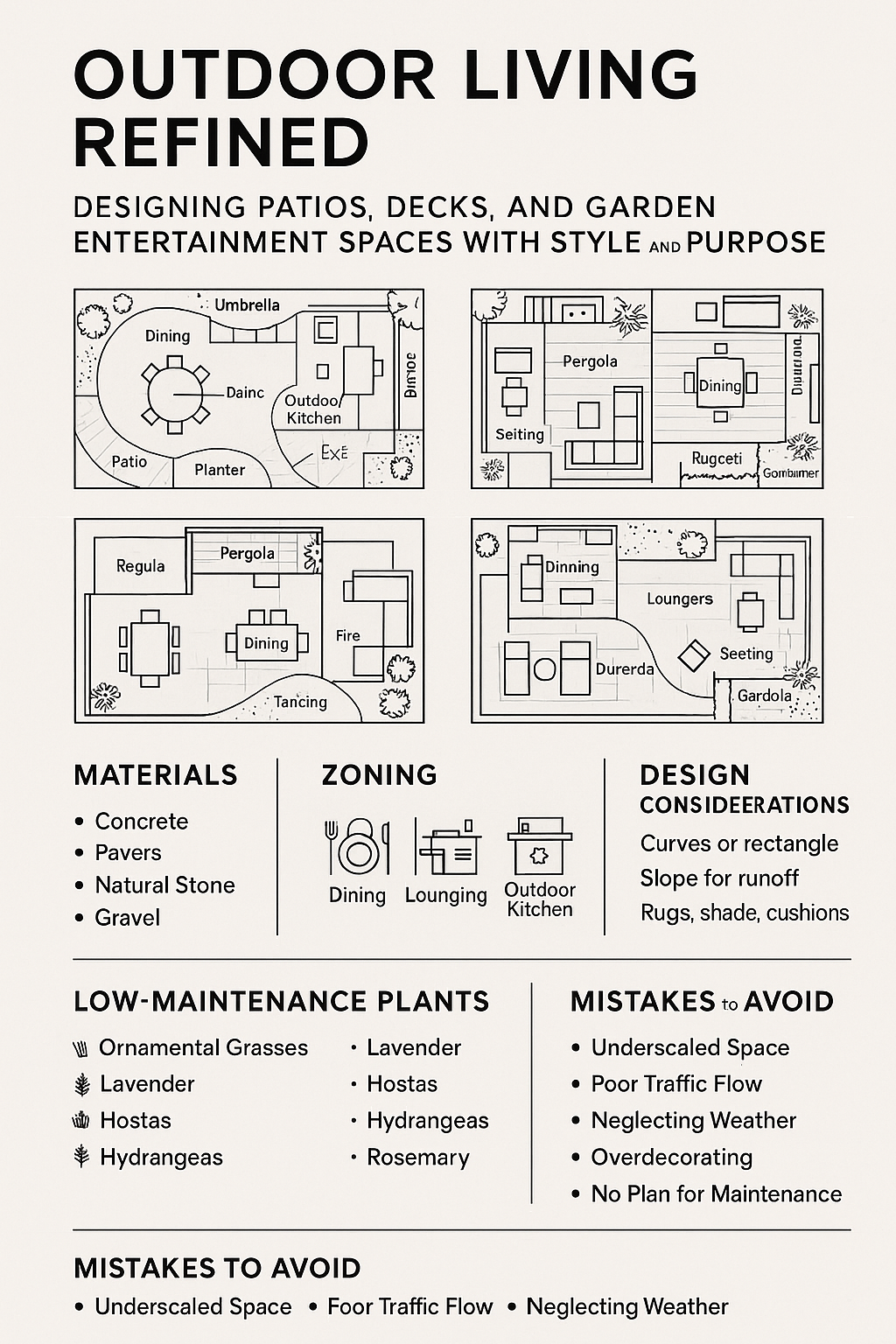This comprehensive guide walks you through designing breathtaking outdoor environments that feel as good as they look—focused on flow, function, and the elements that make your yard a destination.
1. Rethink the Outdoors: What Do You Want From the Space?
Design begins with intent. Before laying one stone or hammering a single nail, ask yourself:
How do you use your yard? Dining, lounging, entertaining, cooking, working?
How many people do you typically host? Design for your reality, not just your Pinterest board.
What’s your climate? Hot, dry areas have different demands than humid or rainy ones.
Do you want year-round use or seasonal? This affects materials and structural features.
2. Patio Design: Foundations for Function and Flow
Patios serve as the groundwork for your outdoor space—literally.
Material Choices
Concrete: Durable, budget-friendly, and now available in stamped or stained options.
Pavers: Elegant and versatile; great for creative layouts and easy repairs.
Natural Stone: Flagstone, slate, or bluestone offer a premium, timeless look.
Gravel: Casual, permeable, and excellent for smaller patios or firepit zones.
Design Considerations
Shape: Curves feel natural; rectangles are more modern and space-efficient.
Zoning: Divide large patios into zones for dining, lounging, or fire features.
Drainage: Ensure a slight slope (1–2%) to prevent water pooling.
Add Comfort
Built-in planters or benches.
Patio covers: pergolas, shade sails, or retractable awnings.
Outdoor rugs and cushions for texture and warmth.
3. Deck Design: Elevate the Experience
Decks offer versatility, height, and unmatched potential for outdoor rooms.
Wood vs. Composite
Pressure-Treated Lumber: Affordable but high maintenance.
Cedar/Redwood: Beautiful and rot-resistant, but require sealing.
Composite Decking: Low maintenance, long-lasting, available in many finishes.
Multi-Level Designs
Add distinct levels for dining, lounging, and grilling.
Use wide stairs or floating steps to maintain open sightlines.
Railings That Complement
Cable railings for a modern, barely-there look.
Glass panels for wind protection and a sleek aesthetic.
Wood or metal for traditional appeal.
4. Garden Entertainment Spaces: Design With Experience in Mind
This is where the magic happens. Thoughtfully designed garden entertainment areas blur the line between indoors and outdoors.
Outdoor Kitchens
Include a grill, prep surface, fridge, and sink if space allows.
Use weather-resistant cabinets and countertops (stainless steel, concrete, or granite).
Cover with a pergola or pavilion for comfort and protection.
Dining Spaces
Long tables for larger gatherings.
Bistro sets for small patios.
Install dimmable lighting overhead or around the perimeter.
Lounge Zones
Sectionals, loungers, and coffee tables define the vibe.
Add fire pits or gas fireplaces as gathering points.
Use raised beds, screens, or trellises to provide visual boundaries.
Sound & Entertainment
Hardwired speakers or Bluetooth systems tucked into landscaping.
Hidden outdoor TVs in weatherproof casings.
Use foliage or fencing to buffer noise from neighbors.
5. Lighting for Ambience and Safety
Lighting transforms outdoor spaces at night—from practical to magical.
Layered Lighting Strategy
Task Lighting: Over cooking or grilling zones.
Ambient Lighting: String lights, sconces, or overhead fixtures.
Accent Lighting: Uplights for trees, lanterns on paths, or LEDs under steps.
Pro Tips
Use warm-white tones (2700K–3000K) for cozy ambiance.
Solar lights are easy to install but can be dim—hardwired systems offer better consistency.
Install smart lighting systems for app control and automation.
6. Integrating Landscaping With Outdoor Structures
Plants should feel intentional, not afterthoughts.
Green Framing
Use tall plants or trellised vines to frame seating areas or create privacy.
Layer shrubs, perennials, and groundcovers for texture and depth.
Low-Maintenance Picks
Drought-tolerant grasses, lavender, or rosemary in hot zones.
Hostas, hydrangeas, and ferns for shaded areas.
Evergreens for year-round structure.
Raised Beds and Containers
Define space while offering flexibility.
Great for herbs, edible flowers, and color accents.
7. Sustainable Design Practices
Beautiful doesn’t have to mean wasteful.
Permeable Surfaces: Reduce runoff and allow water to drain.
Rainwater Capture: Use barrels or cisterns to collect irrigation water.
Native Plants: Lower maintenance and more resilient.
Recycled Materials: Reuse stone, timber, or bricks where possible.
8. Outdoor Design Trends in 2025
Natural Wood Tones: Move away from grey; embrace warmth and grain.
Dark Accents: Charcoal planters, black railings, matte fixtures.
Fire & Water Features: Integrated side-by-side in larger entertainment zones.
Modular Furniture: Adaptable pieces for small or irregular spaces.
Wellness Corners: Hammocks, yoga decks, meditation gardens.
9. Mistakes to Avoid
Avoid these common pitfalls that can derail your design:
Undersized Patio/Deck: Always size for how you’ll use it—not just what fits.
Poor Traffic Flow: Leave space to walk between zones, furniture, and features.
Neglecting Weather: Rain, wind, and sun will dictate material and cover choices.
Overdecorating: Too many features compete—edit your ideas for cohesion.
No Plan for Maintenance: Wood needs sealing; plants need watering—build upkeep into your reality.
10. Conclusion: Design for Living, Not Just Looking
A stunning outdoor space isn't just about aesthetics—it's about how well it lives. It should reflect your habits, withstand your climate, and feel as intentional as any indoor room.
The best outdoor environments balance structure with softness, light with shadow, and form with function. When you plan right, you don’t just build a deck or patio—you create a destination, a mood, a lifestyle.
